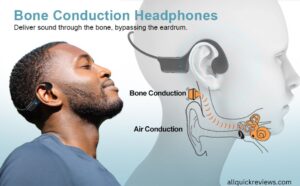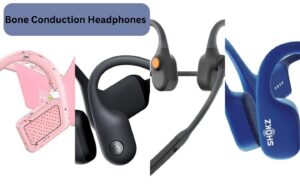
Bone conduction headphones are a type of headphone that transmits sound through the bones of your skull to your inner ear, rather than through the air canal. This means that you can hear the sound without blocking out your surroundings, which can be helpful for activities like running, cycling, and swimming. It works by using small transducers that are placed on the cheekbones, just in front of the ears. These transducers vibrate, creating sound waves that travel through the bones of the skull to the inner ear. The inner ear then interprets these sound waves and sends them to the brain, just like it would with traditional headphones..
However, bone-conduction headphones also have some disadvantages. First, the sound quality is not as good as traditional headphones, especially at low frequencies. Second, they can be more expensive than traditional headphones. Third, they can leak sound, so others may be able to hear what you are listening to.
Top 5 Bone Conduction Headphones:
The best bone-conduction headphones will vary depending on your individual needs and preferences. However, some of the most popular and highly rated bone conduction headphones on the market include:
1. Shokz OpenRun Pro:
The Shokz OpenRun Pro are a great all-around pair of bone conduction headphones. They offer good sound quality, a comfortable fit, and a long battery life. They are also waterproof and sweatproof, making them ideal for use during workouts.
Features of the Shokz OpenRun Pro:
| Feature | Description |
| Bone Conduction Technology | 9th generation technology for clear and powerful sound through bone vibrations |
| Design | Open-ear design for situational awareness |
| Waterproof and Sweatproof | IP55 rating for resistance against sweat and water |
| Comfort | Lightweight and comfortable design |
| Battery Life | Up to 10 hours of playback time |
| Microphones | Built-in noise-canceling microphones for clear phone calls |
| Accessories | Includes carrying case and charging cable |
2. AfterShokz Aeropex:
The AfterShokz Aeropex are another great option for all-around bone-conduction headphones. They offer similar features to the Shokz OpenRun Pro, including good sound quality, a comfortable fit, and a long battery life. However, they are slightly lighter and more compact than the OpenRun Pro, making them a good choice for people who want a more portable pair of headphones.
Features of the AfterShokz Aeropex:
| Features | Description |
| Bone Conduction Technology | PremiumPitch 2.0+ technology for clear and powerful sound transmission through bone conduction. |
| Design | Lightweight and compact design for comfort and portability. |
| Water Resistance | IP67 rated, making them sweatproof and highly water-resistant, suitable for various activities. |
| Battery Life | Up to 8 hours of continuous playback on a single charge. |
| Microphone | Built-in dual noise-canceling microphones for clear calls. |
| Connectivity | Bluetooth connectivity for seamless wireless connection. |
| Controls | Intuitive buttons for easy control of music playback and calls. |
| Usage | Ideal for sports and outdoor activities, providing situational awareness while listening to audio. |
| Accessories | Includes a carrying case and charging cable for convenience on the go. |
3. Jabra Elite 7 Pro Bone Conduction:
The Jabra Elite 7 Pro Bone Conduction are a good option for people who are looking for bone-conduction headphones with excellent sound quality. They also have a number of features that make them ideal for use while exercising, such as Active Noise Cancellation and HearThrough technology.
Features of Jabra Elite 7 Pro Bone Conduction:
| Feature | Description |
| Technology | Active noise cancellation (ANC) and HearThrough mode |
| Connectivity | Bluetooth 5.3 for stable wireless connection |
| Battery Life | Long-lasting battery life |
| Fit | Comfortable and secure fit |
| Water Resistance | Provides protection against water damage |
| Microphone | Built-in microphone for clear voice calls |
4. Vidonn Bone Conduction Headphones F1:
The Vidonn Bone Conduction Headphones F1 feature a lightweight and ergonomic design that makes them comfortable to wear for long periods of time. They are also sweatproof and water-resistant, so you can use them during even the most intense workouts.
Feature of Vidonn Bone Conduction Headphones F1:
| Feature | Description |
| Bone Conduction Technology | Utilizes bone conduction to transmit sound through cheekbones. |
| Design | Lightweight and ergonomic for comfortable long-term wear. |
| Battery Life | Up to 6 hours of playback time on a single charge. |
| Water Resistance | Sweatproof and water-resistant design, suitable for active use. |
| Connectivity | Bluetooth 5.0 for reliable wireless connection with devices. |
| Microphone | Built-in microphone for hands-free calls and voice commands. |
5. Philips Shocks N7505:
The Philips Shocks N7505 are a good option for people who are looking for bone-conduction headphones with a stylish design. They also have a number of features that make them ideal for use while exercising, such as Active Noise Cancellation and HearThrough technology.
Feature of Philips Shocks N7505:
| Feature | Description |
| Design | Lightweight and comfortable design |
| Sound Technology | OpenAir technology for open-ear listening |
| Connectivity | Bluetooth 5.0 connection with built-in microphone |
| Battery Life | Up to 8 hours of playback time, with an additional 16 hours from the charging case |
| Waterproof Rating | Sweatproof and water-resistant |
| Controls | Easy-to-use controls for volume adjustment and call management |
| Comfort | Ergonomic design with soft ear pads for extended wearing comfort |
| Additional Features | Voice assistant support |
| Accessories | Includes charging case and USB-C charging cable |
Applications of Bone Conduction Headphones:
Bone conduction headphones are used in various scenarios, highlighting their versatility:
- Sports and Fitness: Athletes and fitness enthusiasts appreciate these headphones for their comfort and ability to keep them aware of their surroundings during workouts.
- Military and Law Enforcement: These headphones are used in situations where clear communication is essential, but situational awareness cannot be compromised.
- Hearing Aids: Bone conduction principles are applied in hearing aids for individuals with conductive hearing loss.
- Safety-Critical Jobs: Professionals in fields where it’s crucial to hear ambient sounds (e.g., construction workers, cyclists) often use bone conduction headphones.
- Underwater Activities: Some specialized bone conduction headphones are designed for swimming, allowing users to enjoy music or communication underwater.
- Assistive Technology: Used by people with hearing impairments to aid in their everyday activities, enhancing their ability to hear without obstructing their ear canals.
Bone Conduction Headphones Side Effects:
Bone conduction headphones are a unique type of headphones that transmit sound through the bones of your skull. While they have many benefits, there can be some side effects to be aware of:
- Discomfort: Some people may feel uncomfortable wearing bone conduction headphones, especially during long periods. The pressure on the cheekbones can cause discomfort or pain.
- Sound Quality: The sound quality might not be as good as traditional headphones, especially for deep bass. This can be disappointing for people who are used to high-quality sound.
- Hearing Damage: Although bone conduction headphones are generally safer for your eardrums, playing music at very high volumes can still cause hearing damage over time.
- Vibration Sensation: The vibrations from the headphones can feel strange or unpleasant for some users. It might take time to get used to this sensation.
- Less Noise Isolation: Since bone conduction headphones don’t cover your ears, they don’t block outside noise well. This can be a problem in noisy environments or if you want to focus solely on your music or calls.
- Battery Life: These headphones often have shorter battery life compared to traditional ones, requiring more frequent charging.
- Cost: Bone conduction headphones can be more expensive than regular headphones, which might not justify the extra cost for everyone.
It’s important to weigh these side effects against the benefits to decide if bone conduction headphones are the right choice for you.
Note: If you experience any of these side effects, stop using bone-conduction headphones immediately and consult a doctor.
How to Minimize Side Effects of Bone Conduction Headphones
- Keep Volume Safe: Avoid high volumes; take breaks to rest your ears.
- Ensure Proper Fit: Adjust headphones for comfort; choose the right size.
- Limit Usage Time: Avoid prolonged use; take regular breaks.
- Gradually Increase Usage: Start with short sessions and extend gradually.
- Maintain Hygiene: Clean headphones regularly; keep them dry.
- Use in Safe Environments: Be aware of surroundings; avoid noisy areas.
- Follow Manufacturer Guidelines: Read instructions; update firmware.
- Monitor Hearing Health: Get regular check-ups; stop use if discomfort occurs.

Types Of Bone Conduction Headphones:
Wireless Bone Conduction Headphones:
Wireless bone conduction headphones are a type of headphones that transmit sound to your inner ear through the bones in your skull, rather than through your ear canals. This is done using a technology called bone conduction, which vibrates the bones in your skull to create sound waves. Wireless headphones’ bone conduction has a number of advantages over traditional in-ear headphones. First, they are more comfortable to wear, especially for long periods of time. This is because they do not block out external sounds, so you can still hear what is going on around you. This is especially important for safety reasons, such as when running or biking outdoors. Second, bone-conduction wireless headphones are less likely to cause ear infections, as they do not put any pressure on your eardrums. Some of the most popular wireless bone-conduction headphones on the market include the Shokz OpenRun Pro, the AfterShokz Aeropex, and the Zygo Solo. These headphones offer a variety of features, such as long battery life, water resistance, and built-in microphones.
Waterproof Bone Conduction Headphones:
Waterproof bone conduction headphones are designed to withstand exposure to water, making them ideal for activities like swimming, running in the rain, or working out intensely. Here’s a simple overview:
Key Features:
- Waterproof Rating: These headphones have an IP (Ingress Protection) rating, often IPX7 or higher, indicating they can be submerged in water up to a certain depth for a specific time.
- Bone Conduction Technology: They transmit sound through your cheekbones directly to your inner ear, keeping your ear canals open and dry.
- Secure Fit: Designed to stay in place during vigorous activities, they typically have an ergonomic, wraparound design that ensures a snug fit.
- Bluetooth Connectivity: Most models offer Bluetooth connectivity for wireless convenience, though some may also have internal storage for music playback without a Bluetooth connection, which is useful underwater.
- Battery Life: They usually provide several hours of battery life, though it’s important to check the specifications for each model.
Pros:
- Water Resistance: Can be used in the pool, ocean, or during rainy weather without damage.
- Safety: Keeps your ears open, allowing you to remain aware of your surroundings, which is crucial for outdoor activities.
- Comfort: Suitable for people who find traditional earbuds uncomfortable, especially when wet.
Cons:
- Sound Quality: May not offer the same audio quality, particularly in terms of bass, as traditional headphones.
- Vibration Sensation: The sensation of vibrations on your cheekbones might be unusual or uncomfortable for some users.
- Noise Isolation: They don’t block external noise effectively, which can be a drawback in very noisy environments.
Examples of Waterproof Bone Conduction Headphones:
- AfterShokz Xtrainerz: Specifically designed for swimming, offering internal storage for music playback without needing a Bluetooth connection.
- Vidonn F1: Provides good water resistance and a comfortable fit for various activities.
Waterproof bone conduction headphones provide a practical solution for those who want to enjoy music and stay connected during water-based activities or in wet conditions, all while maintaining awareness of their environment.
Bluetooth Bone Conduction Headphones:
Bluetooth bone conduction headphones are a type of headphones that use bone conduction technology to transmit sound to your inner ear and also use Bluetooth technology to connect to your devices. This means that you can use them to listen to music, podcasts, and other audio content wirelessly from your smartphone, tablet, or computer. Bluetooth headphones work by using small transducers that are placed on your cheekbones, just in front of your ears. These transducers vibrate, creating sound waves that travel through the bones of your skull to your inner ear. The inner ear then interprets these sound waves and sends them to the brain, just like it would with traditional headphones.
Bluetooth bone conduction headphones are a modern and innovative type of headphones that use bone conduction technology to transmit sound. Here’s a simple overview:
Key Features:
- Wireless Connectivity: These headphones use Bluetooth to connect to your devices, providing a wireless and hassle-free experience.
- Open-Ear Design: Since they don’t cover your ears, you can stay aware of your surroundings, making them safer for activities like running or cycling.
- Comfort and Fit: They usually have a lightweight and ergonomic design that wraps around the back of your head, ensuring a secure fit during physical activities.
- Battery Life: Most models offer several hours of battery life, but this can vary. It’s important to check battery specifications before purchasing.
- Water Resistance: Many Bluetooth bone conduction headphones are sweat and water-resistant, making them suitable for workouts and outdoor use.
Advantages:
- Awareness: Keeps your ears open so you can hear ambient sounds, which is great for safety.
- Comfort: Ideal for people who find traditional earbuds or headphones uncomfortable.
- Hearing Health: Potentially safer for your hearing as they don’t directly impact your eardrums.
Disadvantages:
- Sound Quality: Might not match the sound quality of traditional headphones, especially in terms of bass.
- Vibration Sensation: Some users might find the vibration sensation on their cheekbones unusual or uncomfortable.
- Noise Isolation: Since your ears are open, they do not block external noise effectively.
Bone Conduction Headphones For Swimming:
Bone conduction headphones designed for swimming are specialized devices that allow swimmers to listen to music or audio while underwater. Here’s how they work and their key features:
Key Features:
- Waterproof Rating: They have a high IP (Ingress Protection) rating, such as IPX8, which means they can be fully submerged in water without water penetrating inside.
- Secure Fit: They typically have a wraparound or headband design that ensures they stay securely in place during swimming strokes and flips.
- Bone Conduction Technology: Unlike traditional headphones that use speakers in or over the ears, bone conduction headphones for swimming bypass the eardrums, allowing swimmers to hear music or audio clearly underwater.
- Internal Storage: Some models come with internal storage for music, allowing you to listen to your favorite tunes without needing a Bluetooth connection while swimming.
- Battery Life: They offer extended battery life to support long swimming sessions.
Benefits:
- Swimming Enjoyment: Enhances the swimming experience by providing entertainment or motivation through music.
- Safety: Maintains situational awareness by allowing swimmers to hear ambient sounds like approaching swimmers or instructions from lifeguards.
- Comfort: Designed to be lightweight and comfortable for extended wear underwater.
Popular Models:
- AfterShokz Xtrainerz: Specifically designed for swimming, offering internal storage and a secure fit.
- FINIS Duo: Waterproof bone conduction headphones with built-in MP3 player for swimming.
Bone conduction headphones for underwater offer a unique solution for swimmers who want to enjoy music or audio entertainment while maintaining safety and comfort underwater.
Do Bone Conduction Headphones Come with Mic?
Yes, many bone-conduction headphones come with a built-in microphone. This allows you to use them for phone calls, video conferencing, and other voice communication tasks. When choosing a pair of bone-conduction headphones with a microphone, it is important to consider factors such as sound quality, battery life, comfort, and the quality of the microphone. It is also important to make sure that the headphones are compatible with your smartphone or other device.
In conclusion, Bone conduction headphones for deaf are a unique and innovative type of headphone that has a number of advantages over traditional headphones. They are more comfortable to wear for long periods of time, safer to use in noisy environments, and helpful for people with hearing loss. Additionally, many headphones are waterproof and wireless. When choosing a pair of bone conduction headphones, it is important to consider the features that are important to you, such as sound quality, fit, battery life, and additional features such as a built-in microphone, noise cancellation, and Hear Through technology.
FAQS:
Q. How do I use bone conduction headphones?
A. To use bone conduction headphones, simply place them on your cheekbones, just in front of your ears. Make sure that the headphones fit snugly but comfortably. Then, adjust the volume to a comfortable level.
Q. How can I avoid ear fatigue when using bone conduction headphones?
A. To avoid ear fatigue when using bone-conduction headphones, take breaks every 30-60 minutes. You can also try using a lower volume setting.
Q. Are bone conduction headphones safe?
A. Bone-conduction headphones are generally considered to be safe. However, some people may experience discomfort or pressure on their cheekbones, temporal bones, or jaw due to the vibrations from bone-conduction headphones. This can lead to headaches in some users. Additionally, these headphones can potentially irritate or exacerbate tinnitus symptoms in some infrequent cases.
Q. What is better earbuds or bone conduction?
A. Wireless earbuds offer better audio quality for unimpaired hearing. Bone conduction headphones work well for those with hearing loss.
